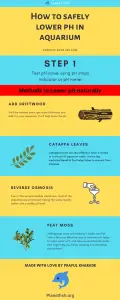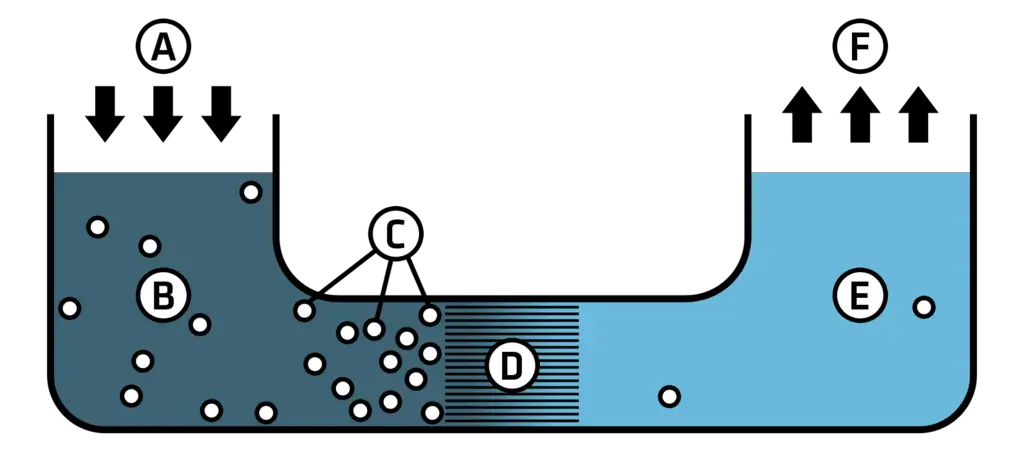In this article, I will discuss How to safely lower pH in aquarium naturally that is safe and provides a natural environment for your fishes.
Water quality is very much important when it comes to fish keeping. Just like how we humans are comfortable with a normal and adjustable environment even fishes deserve to have clean, good quality water with a good pH.
Tap water pH might not be suitable for freshwater aquarium fishes; Hence, It is a great idea to check its pH before adding your fishes inside your tank.
There is a significant difference in pH level between the water that is sitting for about 1-2 days and the water that is coming out directly from your tap.
I will guide you in maintaining and adjusting a pH that keeps your fish happy and healthy.
It’s always a great idea to understand pH and this will help you clear the concept of pH and making your job easier
First and foremost, let us understand.
What is pH?
If you remember your chemistry classes you have already heard this term before.
pH is a term that is widely used in chemistry. pH stands for “power of Hydrogen” or “Potential of Hydrogen”.
It is a scale that is used to specify the acidity or basicity of an aqueous solution. Acidic solutions with a higher concentration of H+ ions are usually measured to have lower pH values than basic alkaline solutions.
The scale used to measure is logarithmic and inversely indicates the concentration of the Hydrogen ions in the solution.
In simple words, At 25 degrees Celcius solutions with less than 7 are acidic and solutions with a pH higher than 7 are basic and the 7 itself is a neutral value.
Usually, pure water is a great example which is at level 7 pH. pH values can also be lesser than 0 i.e negative value with very strong acids, or even higher than 14 with very strong bases.
How to test pH?
There are mainly three methods by which you can test the pH value of your tap water.
- pH measurement with color-changing indicator.
- pH meter.
- Measuring with a Glass electrode.
The above mentioned are the three ways to determine the pH of water.
pH meter
A pH meter is a measurement device for the acidity or alkalinity of a solution – commonly known as pH. It is the measuring unit that describes acidity or alkalinity. The measurement is 0 to 14 in scale. However, pH meters are often used in labs or research and development centers.
pH measurement with color-changing indicator.
A pH indicator is a halochromic chemical compound applied to a solution in small quantities to visually classify the solution’s pH (acidity or basicity). The indicator normally allows the solution color to change in line with pH. For the purpose of aquarium water testing using pH color changing indicator is always preferred.
| Substance | pH range | Type |
|---|---|---|
| Battery acid | < 1 | Acid |
| Gastric acid | 1.0 – 1.5 | |
| Vinegar | 2.5 | |
| Orange juice | 3.3 – 4.2 | |
| Black coffee | 5 – 5.03 | |
| Milk | 6.5 – 6.8 | |
| Pure water | 7 | Neutral |
| Seawater | 7.5 – 8.4 | Base |
| Ammonia | 11.0 – 11.5 | |
| Bleach | 12.5 | |
| Lye | 13.0 – 13.6 |
How to test the pH of freshwater or tap water?
In this section, I will provide a detailed guide on how you should perform a pH value test for your tap or aquarium water.
This is How a pH paper looks like

Follow these simple steps to test the pH of your tap water or Aquarium water
- Take a bucket of tap water you are using and wait for it to sit for at least 18 to 24 hours. Testing the pH of water directly coming out of water gives a variation in values and Hence, researchers recommend to let the water sit for a while and then perform the test.
- Now next, Take a very small amount of this water in a clean container. You will be dipping the pH testing strip deep inside the water. Hence, make sure the water level is deep enough.
- Second, dip one of the test strips for a few seconds in the water container. The test strip will suddenly change color. You will be able to find out the pH degree once the strip has changed color.
- A color chart for the pH test strip would have been given. Using this color map, the dipped pH-testing strip color is matched with the colors shown on the chart to determine the water level of the sample.
There is another way by which you can test the pH of freshwater or tap water.
Litmus paper functions differently when you compare them with pH testing strips and evaluates only whether a solution is acidic or basic.
Follow these steps to test the pH using a Litmus paper
- Firstly, Take a clean container and fill It with test water and ensure that the water depth is sufficiently deep to cover the sheet of paper. Litmus paper are either red or blue.
- Next, Dip the blue or red litmus paper inside of the container and wait for a few seconds.
- There are two possibilities, Either the blue litmus paper will turn red, or Red litmus paper will turn blue depending on the pH level of water. If the water is Basic red litmus paper will turn to blue. Alternatively, If the Blue litmus paper turns red the water is acidic. If either of both the Blue or the red litmus paper doesn’t change its color then the solution is neutral.
As mentioned above the neutral solution will have a pH value of 7. However, this method is not much accurate compared to the pH testing strip method. But, it is still possible to measure the pH value with Litmus paper as well.
Now you are aware of the testing of pH values using various methods.
It’s time for us to safely lower pH in aquarium using Natural methods and this is because Natural methods are safer than lowering in pH of aquarium using chemicals.
The reason why I said this is quite simple, It is hard for people to lower pH using chemicals this might cause problems If you are unaware of using chemicals in the right manner.
Chemicals always give a sudden change to drop pH of water and due to this reason, it is not recommended to use chemicals to lower pH of freshwater.
This will also make your fishes uncomfortable and might also even lead to death in some cases. Hence we recommend you to stick with lowering pH value in aquarium naturally.
Let me introduce you with the methods you should focus on to reduce pH levels.
Methods to safely lower pH level in Aquarium
In this section, I will discuss a few of the methods which you can implement to lower pH level in aquarium in a safer and most effective way. These methods are tried and tested.
Here is an Infographic!

Add Driftwood
This is the most common way used to lower pH levels in aquarium naturally and safely. This is because Driftwood usually releases tannins into your aquarium water that reduces pH level. Visit the nearest store, get some driftwood, and add it to your aquarium.
Driftwood is wood washed by the wind, tides, or waves on the shores or beaches of a sea, lake, or river.
In the wild habitat, driftwood provides shelter and food to many fishes, birds, and other aquatic creatures present in the ocean. As per researchers, Gribbles, shipworms, and bacteria tends to decompose driftwood and will then the driftwood gradually turn into nutrients that are again introduced into the food web.

In occasional times, It has been seen that the partially decomposed driftwood washed away with the waves reaching the shore. This driftwood then acts as a shelter for birds as well as plants.
Nowadays driftwood is being used in the fish keeping industry. They look great and make the fish tank look beautiful and natural. It can even act as a home or shelter for your fishes.
As driftwood contains tannins, It is found to lose some color but this is just color and won’t harm your fishes. Make sure to check before you buy as most of them are colored artificially and contain colors.
Make sure it is safe for your aquatic pets before you buy. Boiling Driftwood inside Saltwater is an effective way to sanitize and is recommended by most of the aquarists.
However, this will help discolor partially preventing it to discolor too much inside your fish tank.
People even use driftwood to make decorative furniture for your home.
Catappa Leaves
Terminalia catappa is a large tropical tree coming from a leadwood tree family, Combretaceae. Catappa leaves is found in the tropical regions of Asia, africa and Australia.
It is also commonly called Country almond, Indian Almond, Malabar almond, sea almond, Tropical almond, Beach almond.

You will see this tree spread widely by humans, so it’s hard to confirm it’s native place. As per the data from Wikipedia, They are extending from Africa to northern Australia and New Guinea through southeast Asia and New guinea. It is even found in most of the Indian subcontinent.
This is widely grown in tropical regions of the world and it is commonly referred to as an ornamental tree. The fruit from this is edible and tastes slightly acidic.
The wood of this tree is red in color and solid. This also has high water resistance.
Fun fact: In tamil, Almond is known as Nattuvadumai
Catappa leaves are very effective when it comes to lower pH in aquarium or freshwater. It even has medicinal benefits that help fishes to prevent diseases.
This will start decomposing with time inside your fish tank and eventually, it releases tannins that will help regulate and maintain pH levels of Aquarium water.
In the field of Ayurveda, It has been seen that these leaves have anti-bacterial properties that will act as medicine for your aquatic pets. Their contribution in lowering down pH safely and naturally without adding any chemical is a gem.
You might notice a slight color change in your fish tank. I presume that should be fine and In my opinion, your fish tank will look more natural due to it’s color. If you don’t like the color change try dipping it in water for sometime before adding to your aquarium.
People while setting up a fish tank make this mistake of maintaining proper pH values while fish keeping.
Reduce pH using Reverse Osmosis

You might have studied about reverse osmosis in your school time.
Reverse osmosis is a process in which a semipermeable membrane is used as a filtering barrier and this allows very small molecules of water to pass through it.
Due to this semipermeable membrane, most of the impurities are eliminated making the water quality better with a stable pH level. This method is widely used in the purification of water in the water filters installed at your home.
RO helps to eliminate heavy metals and insecticides and pesticides from water. If you have noticed the price of water filters they are quite costly and this is due to the Reverse osmosis setup.
Even for using it to lower pH level in freshwater, it might cost you at least a few hundred dollars depending on the product quality.
This is the downside of using this method. But it does have few pros as this will make pH level stable without any need of adding of different materials of chemicals inside your tank.
It’s a safe method and will help you keep your aquarium water stain-free.
Note: Filters might need replacement ocassionally.
If your water is hard then this will help you soften water because fishes have a hard time with hard water.
Peat Moss
Peat Moss is a dead dibrous material that usually forms when mosses and other living are observed decomposing into peat bogs.
As per data, Most of the peat bogs that are being used in the united states come from their neighboring country Canada. It is commonly used by gardeners in potting with soil as it has an acidic pH which makes it ideal for acid-loving plants.
In the world of fish keeping, Peat moss can be used to lower pH of water in a natural and safer way. Peat moss works well when it comes to the removal of contaminants from the water.
Although due to its color you will observe a slight change in color just like Driftwood and catappa leaves. You can also try reducing the discoloration by treating or using it in a different bucket of water.
It might not perfectly reduce the color but it will surely help you to reduce it slightly.
In my opinion, the color should resemble the natural habitat making your fish tank look more attractive and natural. Adding peat moss and keeping it inside your fish tank is the most effective way to maintain pH, helps to make water soft, and also prevents bicarbonates that might help you fishes creating a comfortable environment.
The amount should depend on the hardness of the water. My advice is to try and test it with some sample water and then decide. Keep monitoring your pH level of water and make the alter as per the result.
Adding Alum
Adding alum is mostly used in ponds. This is another method to lower pH in freshwater. This is an emergency method used to reduce pH in water using Alum (aluminum sulfate). This is safe, and when compared to other methods this is a very inexpensive method.
It also removes algae by sedimentation and thus reducing algal biomass. Over addition of Alum has its downside. This might lead to a drastic decrement in the level of pH which is not good.
If you are experienced with the usage of chemicals then this is something you should try. For beginners, It is not advised to use this method if you are not much familiar with using chemicals.
Adding Carbon Dioxide
This method of lowering pH levels of water is longer lasting. It is quite straight forward adding carbon dioxide which acts as an acid in water. Although you can achieve this by adding organic matter like cracked corn, soybean meal or cottonseed meal to ponds.
When the organic matter starts to decay with time it starts releasing carbon dioxide. Adding carbon dioxide to lower pH is a safe method and this is because you are lowering pH slowly. You can also pump carbon dioxide that will help you lower pH.
Here is the video version
Conclusion
First of all, you should note that pH level might make fishes uncomfortable. Although, It is not necessary to alter the pH if your fishes are happy and living fine in your fish tank.
My recommendation is to make changes only if you observe fishes showing uncomfortable behavior. Most of the fishes get adapted to the environment.
There is no need to maintain pH as per data given for a specific fish. It is completely fine to have a 10-15% fluctuation in the pH level. If you see your fishes happy then you don’t have to worry at all.
Most of the fishes are suitable with pH of around 7.3. Staring trying these methods only if you find your fishes unpleasant.
To maintain pH proper maintenance of fish tank is necessary as this will keep the pH levels stable.


mexico drug stores pharmacies: mexican pharmacy online – medicine in mexico pharmacies
mexican online pharmacies prescription drugs
https://cmqpharma.online/# п»їbest mexican online pharmacies
mexico drug stores pharmacies
Great post and right to the point. I don’t know if this is in fact the best place to ask but do you guys have any thoughts on where to
hire some professional writers? Thx 🙂 Lista escape room
Very interesting info!Perfect just what I was searching
for!?
buy prescription drugs from india: reputable indian pharmacies – indian pharmacy
reputable indian online pharmacy [url=https://indiapharmast.com/#]top online pharmacy india[/url] world pharmacy india
https://canadapharmast.online/# canadian pharmacy 365
mexican rx online: mexican online pharmacies prescription drugs – purple pharmacy mexico price list
п»їlegitimate online pharmacies india: best india pharmacy – п»їlegitimate online pharmacies india
india pharmacy [url=http://indiapharmast.com/#]buy medicines online in india[/url] Online medicine home delivery
medication from mexico pharmacy: purple pharmacy mexico price list – reputable mexican pharmacies online
top 10 online pharmacy in india: india pharmacy mail order – indianpharmacy com
https://canadapharmast.online/# canada pharmacy online
best online pharmacies in mexico [url=http://foruspharma.com/#]mexican border pharmacies shipping to usa[/url] reputable mexican pharmacies online
canadian pharmacy review: maple leaf pharmacy in canada – canadian drug pharmacy
top 10 online pharmacy in india: pharmacy website india – india pharmacy mail order
medicine in mexico pharmacies: mexico drug stores pharmacies – reputable mexican pharmacies online
best online pharmacy india [url=https://indiapharmast.com/#]Online medicine order[/url] reputable indian online pharmacy
http://foruspharma.com/# mexican mail order pharmacies
reputable mexican pharmacies online: mexican mail order pharmacies – mexican drugstore online
reliable canadian online pharmacy: best online canadian pharmacy – canadian pharmacy 365
http://doxycyclinedelivery.pro/# doxycycline online usa
https://clomiddelivery.pro/# can i purchase clomid
order cheap clomid now [url=https://clomiddelivery.pro/#]cost generic clomid now[/url] where to buy generic clomid without prescription
https://ciprodelivery.pro/# cipro ciprofloxacin
http://amoxildelivery.pro/# amoxicillin order online
amoxicillin tablets in india [url=https://amoxildelivery.pro/#]amoxicillin 500 mg price[/url] amoxil pharmacy
http://ciprodelivery.pro/# buy cipro online
https://clomiddelivery.pro/# can i get clomid pill
buy amoxicillin 500mg online [url=https://amoxildelivery.pro/#]amoxicillin azithromycin[/url] cost of amoxicillin
https://clomiddelivery.pro/# cost of generic clomid tablets
http://clomiddelivery.pro/# where can i buy clomid for sale
paxlovid pill [url=https://paxloviddelivery.pro/#]Paxlovid buy online[/url] paxlovid pharmacy
https://paxloviddelivery.pro/# paxlovid covid
http://clomiddelivery.pro/# can i get generic clomid online
where can i buy cipro online [url=http://ciprodelivery.pro/#]cipro[/url] buy cipro online canada
http://ciprodelivery.pro/# cipro online no prescription in the usa
http://amoxildelivery.pro/# amoxicillin tablets in india
http://clomiddelivery.pro/# where buy cheap clomid without rx
п»їpaxlovid [url=https://paxloviddelivery.pro/#]paxlovid for sale[/url] buy paxlovid online
https://ciprodelivery.pro/# cipro ciprofloxacin
http://clomiddelivery.pro/# where to get generic clomid
cipro for sale [url=http://ciprodelivery.pro/#]ciprofloxacin mail online[/url] antibiotics cipro
http://doxycyclinedelivery.pro/# buy doxycycline australia